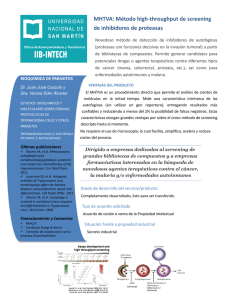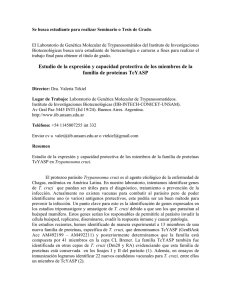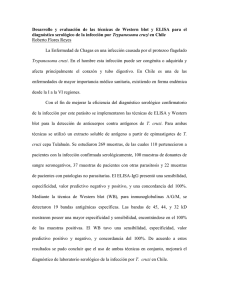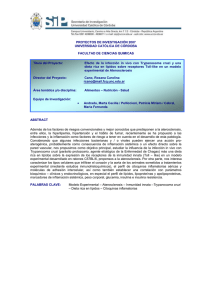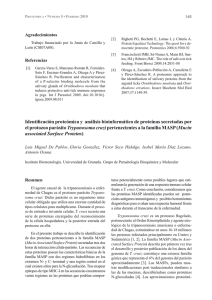rvm39203.pdf
Anuncio
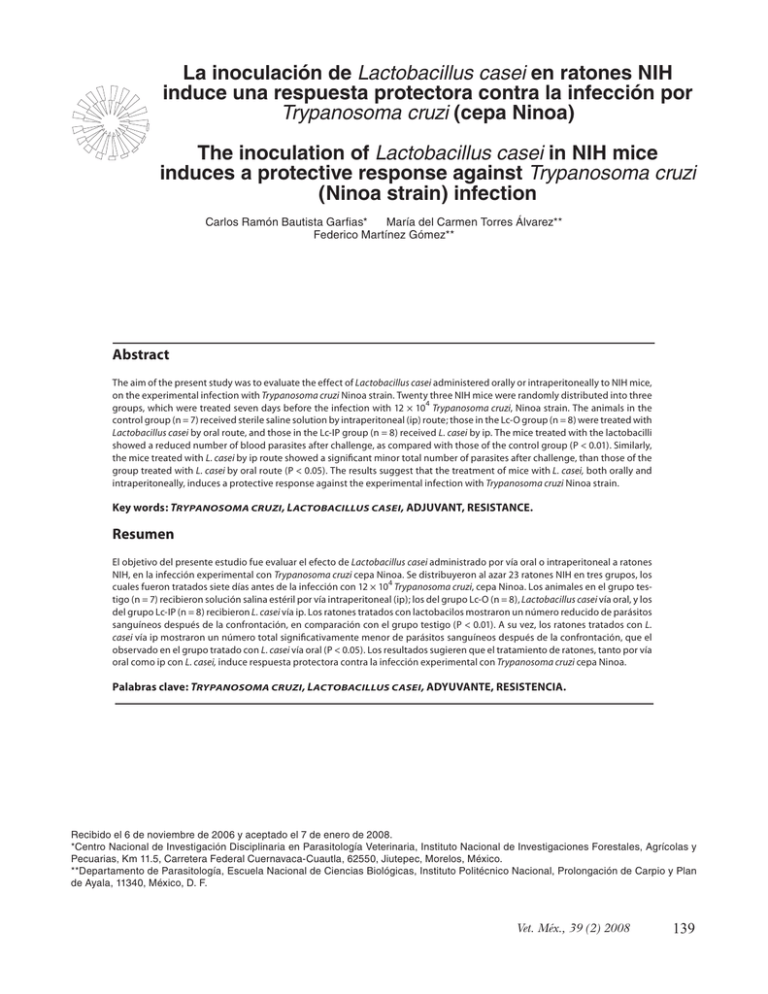
La inoculación de Lactobacillus casei en ratones NIH induce una respuesta protectora contra la infección por Trypanosoma cruzi (cepa Ninoa) The inoculation of Lactobacillus casei in NIH mice induces a protective response against Trypanosoma cruzi (Ninoa strain) infection Carlos Ramón Bautista Garfias* María del Carmen Torres Álvarez** Federico Martínez Gómez** Abstract The aim of the present study was to evaluate the effect of Lactobacillus casei administered orally or intraperitoneally to NIH mice, on the experimental infection with Trypanosoma cruzi Ninoa strain. Twenty three NIH mice were randomly distributed into three groups, which were treated seven days before the infection with 12 × 104 Trypanosoma cruzi, Ninoa strain. The animals in the control group (n = 7) received sterile saline solution by intraperitoneal (ip) route; those in the Lc-O group (n = 8) were treated with Lactobacillus casei by oral route, and those in the Lc-IP group (n = 8) received L. casei by ip. The mice treated with the lactobacilli showed a reduced number of blood parasites after challenge, as compared with those of the control group (P < 0.01). Similarly, the mice treated with L. casei by ip route showed a significant minor total number of parasites after challenge, than those of the group treated with L. casei by oral route (P < 0.05). The results suggest that the treatment of mice with L. casei, both orally and intraperitoneally, induces a protective response against the experimental infection with Trypanosoma cruzi Ninoa strain. Key words: TRYPANOSOMA CRUZI , LACTOBACILLUS CASEI , ADJUVANT, RESISTANCE. Resumen El objetivo del presente estudio fue evaluar el efecto de Lactobacillus casei administrado por vía oral o intraperitoneal a ratones NIH, en la infección experimental con Trypanosoma cruzi cepa Ninoa. Se distribuyeron al azar 23 ratones NIH en tres grupos, los cuales fueron tratados siete días antes de la infección con 12 × 104 Trypanosoma cruzi, cepa Ninoa. Los animales en el grupo testigo (n = 7) recibieron solución salina estéril por vía intraperitoneal (ip); los del grupo Lc-O (n = 8), Lactobacillus casei vía oral, y los del grupo Lc-IP (n = 8) recibieron L. casei vía ip. Los ratones tratados con lactobacilos mostraron un número reducido de parásitos sanguíneos después de la confrontación, en comparación con el grupo testigo (P < 0.01). A su vez, los ratones tratados con L. casei vía ip mostraron un número total significativamente menor de parásitos sanguíneos después de la confrontación, que el observado en el grupo tratado con L. casei vía oral (P < 0.05). Los resultados sugieren que el tratamiento de ratones, tanto por vía oral como ip con L. casei, induce respuesta protectora contra la infección experimental con Trypanosoma cruzi cepa Ninoa. Palabras clave: TRYPANOSOMA CRUZI , LACTOBACILLUS CASEI , ADYUVANTE, RESISTENCIA. Recibido el 6 de noviembre de 2006 y aceptado el 7 de enero de 2008. *Centro Nacional de Investigación Disciplinaria en Parasitología Veterinaria, Instituto Nacional de Investigaciones Forestales, Agrícolas y Pecuarias, Km 11.5, Carretera Federal Cuernavaca-Cuautla, 62550, Jiutepec, Morelos, México. **Departamento de Parasitología, Escuela Nacional de Ciencias Biológicas, Instituto Politécnico Nacional, Prolongación de Carpio y Plan de Ayala, 11340, México, D. F. Vet. Méx., 39 (2) 2008 139 Introduction Introducción T rypanosoma cruzi es un protozoario parásito que produce la infección conocida como enfermedad de Chagas o tripanosomiasis americana, que es transmitida naturalmente por insectos vectores triatomineos hematófagos a cerca de 150 especies de mamíferos domésticos y silvestres. Esta enfermedad es una zoonosis que se encuentra presente en 18 países del continente americano en dos zonas ecológicas diferentes: la región del Cono Sur y la región de Centroamérica y México.1 Entre las especies de animales domésticos que infecta T. cruzi se encuentran: bovinos, 2 cabras, 3 cerdos4 y perros.4,5 En 2002, la Organización Mundial de la Salud informó que alrededor de 17.4 millones de personas estaban afectadas por la enfermedad de Chagas.6 En 2001 se estimó que 156 488 personas en México estaban infectadas con T. cruzi.7 En 2003 se determinó una prevalencia de la infección de 13 millones, de 3 a 3.3 millones de casos sintomáticos e incidencia anual de 200 mil casos en 15 países.1 Para 2005 se estimó que sólo en Guanajuato estaban en riesgo de infectarse 3 755 380 individuos, con una incidencia anual de 3 500 casos nuevos.8 Con base en lo anterior y en un análisis de información publicado en los últimos 76 años, se considera que en México la enfermedad de Chagas es de los males parasitarios más importantes.9 La tripanosomiasis es un problema de salud prioritario entre otras razones debido a: a) la necesidad de vigilancia y control en áreas donde los vectores silvestres pueden invadir las viviendas; b) los costos médicos y sociales del cuidado de la gente infectada, debido a la falta de una terapia bien tolerada, especialmente contra la forma crónica de la enfermedad.1 Asimismo, el tratamiento se debe administrar a los pacientes cuando la enfermedad se encuentra en la fase aguda, lo cual es muy difícil de detectar, no hay tratamiento preventivo, y hasta el momento no existe vacuna disponible,10 por lo que es necesario buscar alternativas para su control. Diversos estudios han demostrado que es posible inducir resistencia no específica contra la infección por Trichinella spiralis y Babesia microti en ratones,11,12 y contra la infección por tres especies de Eimeria en pollos de engorda,13 por medio de la administración de la bacteria Lactobacillus casei. En este trabajo se evaluó el efecto de dicha bacteria sobre la infección por Trypanosoma cruzi en ratones NIH. rypanosoma cruzi is a protozoan parasite that causes Chagas’ disease or American trypanosomiasis, which is naturally transmitted by bloodsucking triatomine vectors to almost 150 species of domestic and wild mammals. The disease is present in 18 countries of the American Continent in two different ecologic areas: South Cone region and Central America and Mexico region.1 Cattle, 2 goats, 3 swine4 and dogs4,5 are some of the domestic animals species which infects T. cruzi. In 2002, the World Health Organization informed that approximately 17. 4 million persons were affected by Chagas’ disease.6 In 2001, it was estimated that 156 488 persons in Mexico were infected with T. cruzi.7 In 2003 an infection prevalence of 13 millions was estimated, with 3 to 3.3 millions of asymptomatic cases and an annual incidence of 200 000 cases in 15 countries.1 In Guanajuato State only, in 2005, it was estimated that 3 755 380 individuals were in risk of suffering the disease, with an annual incidence of 3 500 new cases.8 In accordance with the previous information and on one analysis of the information published in the last 76 years, Chagas’ disease is one of the most important parasitic diseases in Mexico.9 Trypanosomiasis is a priority health issue due to: a) the need for surveillance and control in those areas where the wild vectors can invade houses; b) the medical and social costs of taking care of infected people, due to the lack of a well tolerated therapy, specially when the disease is chronic.1 Likewise, the treatment must be administrated when the disease is in the acute phase, which is very difficult to detect, there is no preventive treatment, and so far there is not an available vaccine,10 for these reasons there is the need to search for control alternatives. Several studies have demonstrated that it is possible to induce non-specific resistance against Trichinella spiralis and Babesia microti infections in mice,11,12 and against the infection with three Eimeria species in broilers,13 by using the bacteria Lactobacillus casei. In this study the effect of such bacteria on the infection with Trypanosoma cruzi in NIH mice was evaluated. Material and methods Experimental animals NIH female mice, 2-3 months old, with an average weight of 20 g were used, to which a coproparasitoscopic test was carried out to check that they were not parasitized. Then they were housed in acrylic cages with sterilized sawdust and were fed with commercial food and water ad libitum. 140 T Material y métodos Animales experimentales En el estudio se usaron ratones NIH hembras, de dos Parasite The Trypanosoma cruzi, Ninoa strain, was utilized. This has been maintained by cryopreservation in liquid nitrogen at the Parasitology Department of the National School of Biological Sciences of the National Polytechnic Institute. This strain is regularly reactivated by serial passage in NIH mice. Microorganisms The Lactobacillus casei, ATCC7469 strain, was cultured in MRS medium at 37°C during 18 h. The microorganisms were harvested by centrifugation at 5 000 g for 10 min, then they were washed several times with sterile saline solution (ss),11 then the viable count was determined and the inoculum was adjusted to the desired concentration (cfu).11 Experimental design Twenty three NIH mice were randomly allocated into three groups: those in group I (n = 7) served as control and received ss by intraperitoneal route (ip) at day 0. Those in group II (n = 8) were inoculated at day 0 by ip route with 1 × 10 9 cfu of Lactobacillus casei, ATCC7469 strain. Mice in group III (n = 8) received the same L. casei inoculum by oral route at day 0. At day seven after treatment, each mouse in the three groups was inoculated by ip route with 12 × 104 blood trypomastigotes of T. cruzi, Ninoa strain, obtained from previously infected animals; then they were quantified (in a Neubauer chamber) and adjusted with ss to the desired concentration. Beginning on day three after challenge (ac), the parasitaemia was evaluated (number of parasites/5 µL of blood) every other day by quantifying blood parasites. Assessment of blood trypomastigotes In accordance with Brener,14 5 mm3 of blood were collected from the tail of each mouse, and compressed between a slide and a coverslip to obtain a single layer of blood cells. The number of trypomastigotes in the 5 mm3 (µL) of blood was assessed by counting the observed parasites in 50 fields in the optical compound microscope and then the obtained value was multiplied by 70.14 y tres meses de edad, con peso promedio de 20 g, a los que se les practicó un examen coproparasitoscópico para verificar que no estuvieran parasitados. Luego, bajo condiciones adecuadas de bioterio, se alojaron en jaulas de acrílico con aserrín esterilizado y se les dio alimento comercial y agua ad libitum. Parásito Se utilizó la cepa Ninoa de Trypanosoma cruzi que se ha mantenido en criopreservación en nitrógeno líquido en el Departamento de Parasitología de la Escuela Nacional de Ciencias Biológicas, del Instituto Politécnico Nacional. Dicha cepa se reactiva regularmente por pases seriados en ratones NIH. Microorganismos Se utilizó la cepa ATCC7469 de Lactobacillus casei cultivada en medio MRS a 37°C durante 18 h. Los microorganismos fueron cosechados por centrifugación a 5 000 g por 10 min, se lavaron varias veces con solución salina estéril,11 luego se determinó la cuenta viable y finalmente se ajustó a la concentración deseada (ufc).11 Diseño experimental Veintitrés ratones NIH fueron distribuidos al azar en tres grupos: los del grupo I (n = 7) fungieron como testigo y recibieron solución salina estéril por vía intraperitoneal (ip) el día 0. Los del grupo II (n = 8) fueron inoculados el día 0 por vía ip con 1 × 10 9 ufc de Lactobacillus casei, cepa ATCC-7469. A los animales del grupo III (n = 8) se les administró la misma dosis de L. casei, pero por vía oral, el día cero. Siete días después del tratamiento, cada uno de los ratones de los tres grupos fue inoculado por vía ip con 12 × 104 tripomastigotes sanguíneos de T. cruzi cepa Ninoa, que se obtuvieron de animales previamente infectados y luego se cuantificaron (en cámara de Neubauer) y se ajustaron con solución salina estéril a la concentración indicada. A partir del día tres posinfección (p i) se evaluó la parasitemia (número de parásitos/5 µL de sangre) cada tercer día, por medio de la cuantificación de parásitos sanguíneos. Determinación de tripomastigotes sanguíneos Statistical analysis Data were analyzed by an analysis of variance (random blocks) and when there were differences, the Tukey test was used.15 De acuerdo con Brener,14 se recolectaron 5 mm3 de sangre fresca de la cola de cada ratón, que fueron comprimidos entre un portaobjetos y un cubreobjetos para formar una sola capa de células sanguíneas. El número de tripanosomas en los 5 mm3 (µL) de sangre Vet. Méx., 39 (2) 2008 141 Results Análisis estadístico Se practicó un análisis de varianza (bloques al azar) con los datos obtenidos, y cuando hubo diferencias, éstas fueron sometidas a la prueba de Tukey.15 Resultados Los resultados indicaron que el tratamiento de ratones con Lactobacillus casei, tanto oral como intraperitoneal, redujo el número de parásitos sanguíneos, en comparación con el grupo testigo. Desde el día seis hasta el día 28 posconfrontación, se observó diferencia significativa (P < 0.01) en el promedio de tripomastigotes sanguíneos en 5 µL de sangre entre los ratones del grupo testigo y los de los grupos tratados con Lactobacillus casei (Figura 1). El máximo número promedio de parásitos (tripomastigotes en 5 µL de sangre) para los tres grupos se presentó los días 18 (30 070 + EE 7 206), 20 (2 966 ± EE 501) y 24 (6 116 ± EE 3 800), para los grupos testigo, L. casei intraperitoneal y L. casei oral, respectivamente (Figura 1). Cuando se comparó el promedio total de parásitos sanguíneos durante el periodo de parasitemia comprendido entre los días 10 y 28 posconfrontación, × L L The results showed that the treatment (oral or intraperitoneal) with Lactobacillus casei reduced the number of blood parasites in mice, as compared with the control group. From day six to day 28 after challenge, a significant difference (P < 0.01) was observed in the mean number of blood trypomastigotes in 5 µL of blood from mice in the control group and those in the groups treated with Lactobacillus casei (Figure 1). The maximum mean number of blood parasites (trypomastigotes in 5 µL of blood) was observed at days 18 (30 070 ± SE 7 206), 20 (2 966 ± SEM 501) and 24 (6 116 ± SEM 3 800) in control, L. casei- Mintraperitoneal and L. casei-oral groups, respectively (Figure 1). When the total mean of blood parasites during the parasitaemia occurring between days 10 and 28 after challenge, between the groups Lc-O (mean: 3 820 + SE 1 351) and Lc-IP (mean: 1 842.6 ± SE 651.4) a significant difference was observed (P < 0.05) (Figure 2), which suggests that the intraperitoneal treatment with L. casei was more effective than the oral treatment for the induction of resistance against Trypanosoma cruzi, Ninoa strain. fue determinado contando los parásitos observados en 50 campos en el microscopio óptico y luego multiplicando ese número por 70.14 × Figura 1: Promedio (+ EEM) de tripomastigotes sanguíneos en 5 µL de sangre extraída de la cola de ratones NIH tratados por vía oral (Lc-O) o intraperitoneal (Lc-IP) con Lactobacillus casei, siete días antes de la infección con 120 mil tripomastigotes de Trypanosoma cruzi cepa Ninoa. Cada punto representa el promedio de siete a ocho ratones. * Diferencia del grupo testigo con respecto a los otros dos grupos (P < 0.01). Figure 1: Mean of blood trypomastigotes (+ SEM) in 5 µL of tail blood from NIH mice treated orally (Lc-O) or intraperitoneally (LcIP) with Lactobacillus casei, seven days before challenge with 120 000 Trypanosoma cruzi (Ninoa strain) trypomastigotes. Each point represents the average of seven to eight mice. * Control group difference with respect to the other two groups (P < 0.01). 142 DAYS AFTER CHALLENGE Figura 2: Promedio total (+ EEM) de tripomastigotes sanguíneos entre los dias 10 y 28 posinfección, de ratones NIH tratados por vía oral (Lc-O) o intraperitoneal (Lc-IP) con Lactobacillus casei siete días antes de la confrontación con120 mil tripomastigotes de Trypanosoma cruzi, cepa Ninoa. Entre el grupo Lc-O y el Lc-IP se observó diferencia significativa (P < 0.05, prueba de Tukey). Figure 2: Mean of blood trypomastigotes (+ SEM) between days 10 and 28 after challenge, in NIH mice treated orally (Lc-O) or intraperitoneally (Lc-IP) with Lactobacillus casei, seven days before challenge with 120 000 Trypanosoma cruzi (Ninoa strain) trypomastigotes. A significant difference was observed between group Lc-O and group Lc-IP (P < 0.05, Tukey’s test). Discussion It has been emphasized that the host innate immune response is essential for the control of the acute Trypanosoma cruzi infection16 and that this depends on the Toll like receptors (TLRs). In this respect, the TLRs are fundamental molecules for the activation of the host immune mechanisms, not only those of the innate immune response but also those of the acquired immune response.17 Studies carried out in mice indicate that the oral administration of Lactobacillus casei stimulates the immune system through the innate immunity, which involves the activation of the TLRs.18 NK cells are also important in the innate immune response, because they carry out a protective role in the early phase of T. cruzi infection by producing interferon gamma, cytokine which presumably controls the early parasite replication in the macrophages.19 In this context, in previous studies it was demonstrated that the ip inoculation of L. casei in mice before the infection with Trichinella spiralis induces the production of interferon gamma.20 On the basis of the previous information and the results obtained in the present study it is suggested that the observed protection against T. cruzi was caused by the activation of the innate immune response by L. casei and it is supported by other studies in which it was demonstrated that the administration of L. casei in broilers and in NIH mice before the challenge with intracellular protozoa induces a protective response against Eimeria spp13 and Babesia microti,12 respectively. The observation that the administration of lactobacilli by intraperitoneal route induced a better protective response as compared with the protection obtained when they were administrated by oral route, probably was caused by the direct stimulation of GALT (lymphoid tissue associated with the gut) of lactobacilli in the inoculum administered intraperitoneally, while the lactobacilli in the oral inoculum stimulated indirectly the GALT; in other words, the stimulation occurred after the processing of dead lactobacilli colonizing the intestinal mucosa by immune cells of GALT. In accordance with the results of the present investigation, it is concluded that the administration of Lactobacillus casei by oral or intraperitoneal routes to NIH mice induces a protective nonspecific immune response against the experimental infection with Trypanosoma cruzi, Ninoa strain. Likewise, it is suggested to carry out other studies to elucidate the mechanisms involved in the protective immune response so induced. entre los grupos Lc-O (promedio: 3 820 + EE 1 351) y Lc-IP (promedio: 1 842.6 + EE 651.4) se observó diferencia significativa (P < 0.05) (Figura 2); este resultado indica que el tratamiento intraperitoneal con L. casei es más efectivo que el oral para generar resistencia contra Trypanosoma cruzi cepa Ninoa. Discusión Se ha señalado que la respuesta inmunitaria innata del portador es esencial para el control de la infección aguda por Trypanosoma cruzi16 y que es dependiente de los receptores tipo Toll (TLR, por sus siglas en inglés). Cabe señalar que los TLR son moléculas fundamentales para la activación de los mecanismos inmunitarios del portador, no sólo de la respuesta inmunitaria innata sino también de la respuesta inmunitaria adquirida.17 Estudios realizados en ratones indican que la administración oral de Lactobacillus casei estimula el sistema inmunitario a través de la inmunidad innata, que involucra la activación de los receptores tipo Toll.18 Las células NK son importantes para la respuesta inmunitaria innata, pues desempeñan un papel protector en la fase temprana de la infección por T. cruzi al producir interferón gamma, citocina que presumiblemente controla la replicación temprana del parásito en los macrófagos.19 En este contexto, en estudios previos se ha demostrado que la inoculación ip de L. casei en ratones antes de la infección con Trichinella spiralis induce la producción de interferón gamma.20 Con base en lo anterior, los resultados obtenidos aquí sugieren que la protección observada contra T. cruzi se debió a la activación de la respuesta inmunitaria innata por L. casei y son apoyados por otros estudios en los que se demostró que la administración de L. casei en pollos de engorda y en ratones NIH antes de la confrontación con protozoarios intracelulares, genera respuesta protectora contra Eimeria spp13 y Babesia microti,12 respectivamente. La observación de que la administración de los lactobacilos por vía intraperitoneal generó mejor respuesta protectora que cuando fueron administrados por vía oral, quizá se deba a que el tejido linfoide asociado con el intestino (GALT, por sus siglas en inglés) fue directamente estimulado por las bacterias del inóculo intraperitoneal, mientras que los lactobacilos del inóculo oral estimularon al GALT de manera indirecta, o sea, la estimulación se realizó después de que las bacterias que colonizaban la mucosa intestinal murieron y luego fueron procesadas por las células inmunocompetentes del GALT. De acuerdo con los resultados del presente estudio, se concluye que la administración de Lactobacillus casei por vía oral o intraperitoneal a ratones NIH induce respuesta inmunitaria inespecífica protectora contra Vet. Méx., 39 (2) 2008 143 Referencias 1. Morel CM, Lazdins J. Chagas disease. Nat Rev Microbiol 2003;1:14-15. 2. Guzmán-Bracho C. Enfermedad de Chagas en Progreso, Jiutepec, Mor. I. Encuesta seroepidemiológica (tesis de especialidad). México DF: Instituto de Salubridad y Enfermedades Tropicales, Secretaría de Salud, 1985. 3. Rozas M, Botto-Mahan C, Coronado X, Ortiz S, Cattan PE, Solari A. Short report: Trypanosoma cruzi infection in wild mammals from a chagasic area of Chile. Am J Trop Med Hyg 2005;73:517-519. 4. Salazar-Schettino PM, Bucio MI, Cabrera M, Bautista J. First case of natural infection in pigs. Review of Trypanosoma cruzi reservoirs in Mexico. Mem Inst Oswaldo Cruz 1997;92:499-502. 5. Beard CB, Pye G, Steurer FJ, Rodriguez R, Campman R, Peterson AT et al. Chagas disease in a domestic transmission cycle in southern Texas, USA. Emerg Infect Dis 2003;9:103-105. 6. World Health Organization. Control of Chagas disease: second report of the WHO expert committee. UNDP/ WHO. Geneva: The Organization, 2002. 7. Guzman-Bracho C. Epidemiology of Chagas disease in Mexico: an update. Trends Parasitol 2001;17:372-376. 8. Lopez-Cardenas J, Gonzalez FE, Salazar PM, Gallaga JC, Ramirez E, Martinez J et al. Fine-scale predictions of distributions of Chagas disease vectors in the state of Guanajuato, Mexico. J Med Entomol 2005;42:10681081. 9. Cruz-Reyes A, Pickering-Lopez JA. Chagas disease in Mexico: an analysis of geographical distribution during the past 76 years – A review. Mem Inst Oswaldo Cruz, Rio de Janeiro 2006;101:345-354. 10. Anonimo. Department of Health and Human Services. Chagas disease. Centers for Disease Control and Prevention. Division of Parasitic Diseases. Facts sheet. 2004:1-3. 11. Bautista-Garfias CR, Ixta-Rodriguez O, MartinezGomez F, Lopez MG, Aguilar-Figueroa BR. Effect of viable or dead Lactobacillus casei organisms adminis- 144 la infección experimental por Trypanosoma cruzi, cepa Ninoa. Asimismo, se sugiere que se lleven a cabo más estudios para esclarecer los mecanismos involucrados en la generación de la respuesta protectora. tered orally to mice on resistance against Trichinella spiralis infection. Parasite 2001; 8: S226-228. 12. Bautista-Garfias CR, Gomez MB, Aguilar BR, Ixta O, Martinez F, Mosqueda J. The treatment of mice with Lactobacillus casei induces protection against Babesia microti infection. Parasitol Res 2005;97:472-477. 13. Bautista-Garfias CR, Arriola MT, Trejo L, Ixta O, Rojas EE. Comparative effect between Lactobacillus casei and a commercial vaccine against coccidiosis in broilers. Téc Pecu Méx 2003;41:317-327. 14. Brener Z. Therapeutic activity and criterion of cure on mice experimentally infected with Trypanosoma cruzi. Rev Inst Med Trop Sao Paulo 1962;4:389-396. 15. Olivares Sáenz E. Paquete de diseños experimentales. Marín (NL) México: Facultad de Agronomía. Universidad Autónoma de Nuevo León, 1994. 16. Oliveira AC, Peixoto JR, de Arruda LB, Campos MA, Gazzinelli RT, Golenbock DT et al. Expression of functional TLR4 confers proinflammatory responsiveness to Trypanosoma cruzi glycoinositolphospholipids and higher resistance to infection with T. cruzi. J Immunol 2004;173:5688-5696. 17. Bautista Garfias CR, Mosqueda JJ. Papel de los receptores tipo Toll y su implicación en Medicina Veterinaria. Vet Méx 2005;36:453-468. 18. Maldonado Galdeano C, Perdigón G. The probiotic bacterium Lactobacillus casei induces activation of the gut mucosal immune system through innate immunity. Clin Vaccine Immunol 2006;13:219-226. 19. Cardillo F, Voltarelli JC, Reed SG, Silva JS. Regulation of Trypanosoma cruzi infection in mice by gamma interferon and interleukin 10: role of NK cells. Infect Immun 1996;64:128-134. 20. Bautista-Garfias CR, Ixta O, Orduña M, Martinez F, Aguilar B, Cortes A. Enhancement of resistance in mice treated with Lactobacillus casei: effect on Trichinella spiralis infection. Vet Parasitol 1999;80:251-260. Patogenia de Salmonella enteritidis FT 13a y Salmonella enteritidis biovar Issatschenko en pollos de engorda Pathogenesis of Salmonella enteritidis PT 13a and Salmonella enteritidis biovar Issatschenko in broiler chickens Griselda Ruiz Flores* Fernando Constantino Casas** José Antonio Quintana López* Carlos Cedillo Peláez** Odette Urquiza Bravo* Abstract The objective of this study was to determine Salmonella enteritidis phage type 13a (SE PT 13a) and Salmonella enteritidis biovar Issatschenko phage type 6a (SI) pathogenesis in 4 days old broiler chickens. Twenty-eight birds per treatment were inoculated with a dose of 1×108 (SE PT 13a) and 1×109 (SI), respectively, and fourteen chickens were inoculated with physiological saline solution (PSS) as negative controls. Samples from liver, spleen, heart, lung, crop, duodenum, jejunum, ileum and blind guts were taken during fourteen different times postinfection (6, 18, 30, 42, 54, 78, 102, 126, 150, 174, 198, 222, 246 and 270 hours postinfection (hpi) in order to obtain Salmonella spp isolation for bacteriological, histopathological and ultrastructural examination. During the first week, some depressed birds were observed, and the second week birds were found with yolk sac retention in both treatments. SE PT 13a was isolated at 18, 30, 42, 54, 78, 102, 126, 150, 174, 198, 246 and 270 hpi from all organs previously described. SI was isolated at 42, 150, 174 and 222 hpi, from crop, jejunum, ileum and blind gut samples. Ileum was the main organ where more frequently SE PT 13a and SI were isolated. There was no mortality in either treatments. Histopathology revealed inflammation, coagulative necrosis, congestion and hemorrhages in gastrointestinal tract (GIT) and visceral organs since 6 hpi in both treatments, with lesions from mild to severe. Ultrastructurally changes in enterocytes’ cytoplasm: degeneration, necrosis, invasion and penetration of SE PT 13a and SI were observed. Results of this research showed the ability of SE PT 13a as well as SI to penetrate and invade enterocytes in experimentally infected broiler chicken, demonstrating that SI is able to infect broiler chickens and not only Muridae family. Key words: PATHOGENESIS OF SALMONELLA , ISOLATION OF SALMONELLA , SALMONELLA IN BROILER CHICKENS. Resumen El objetivo del presente estudio fue determinar la patogenia de Salmonella enteritidis fagotipo 13a (SE FT 13a) y de Salmonella enteritidis biovar Issatschenko fagotipo 6a (SI) en pollitos de engorda de cuatro días de edad. Veintiocho aves por tratamiento fueron inoculadas con dosis de 1 × 10 8 (SE FT 13a) y 1 × 109 (SI), respectivamente, y 14 pollitos fueron inoculados con solución salina fisiológica (SSF), como testigos negativos. Se tomaron muestras de hígado, bazo, corazón, pulmón, buche, duodeno, yeyuno, íleon y ciegos durante 14 tiempos posinfección (6, 18, 30, 42, 54, 78, 102, 126, 150, 174, 198, 222, 246 y 270 horas posinfección (hpi)), para realizar el aislamiento bacteriológico de Salmonella spp, exámenes histopatológico y ultraestructural. Durante la primera semana, se observó que algunas aves estaban deprimidas, y en la segunda semana se encontraron aves con retención de saco vitelino en ambos tratamientos. Se aisló SE FT 13a a partir de las 18, 30, 42, 54, 78, 102, 126, 150, 174, 198, 246 y 270 hpi, en todos los órganos previamente descritos. SI fue aislada a las 42, 150, 174 y 222 hpi de muestras de buche, yeyuno, íleon y ciegos. El íleon fue el órgano de donde se aisló SE FT 13a y SI con mayor frecuencia. No se registró mortalidad en ningún tratamiento. El examen histopatológico reveló inflamación, necrosis coagulativa, congestión y hemorragias en tracto gastrointestinal (TGI) y órganos viscerales a partir de las 6 hpi en ambos tratamientos, con grados de lesión de leve a severo. Ultraestructuralmente se observaron cambios en el citoplasma celular de enterocitos: degeneración, necrosis, invasión y penetración de SE FT 13a y SI. Los resultados de la presente investigación evidenciaron la capacidad de SE FT 13a y SI para penetrar e invadir enterocitos de los pollitos infectados experimentalmente, demostrando que SI es capaz de infectar pollos de engorda y no sólo a la familia Muridae. Palabras clave: PATOGENIA DE SALMONELLA , AISLAMIENTO DE SALMONELLA , SALMONELLA EN POLLOS DE ENGORDA. Recibido el 5 de julio de 2006 y aceptado el 8 de enero de 2008. *Departamento de Producción Animal: Aves, Facultad de Medicina Veterinaria y Zootecnia, Universidad Nacional Autónoma de México, 04510, México, D. F. **Departamento de Patología Veterinaria, Facultad de Medicina Veterinaria y Zootecnia, Universidad Nacional Autónoma de México, 04510, México, D. F. Vet. Méx., 39 (2) 2008 145
